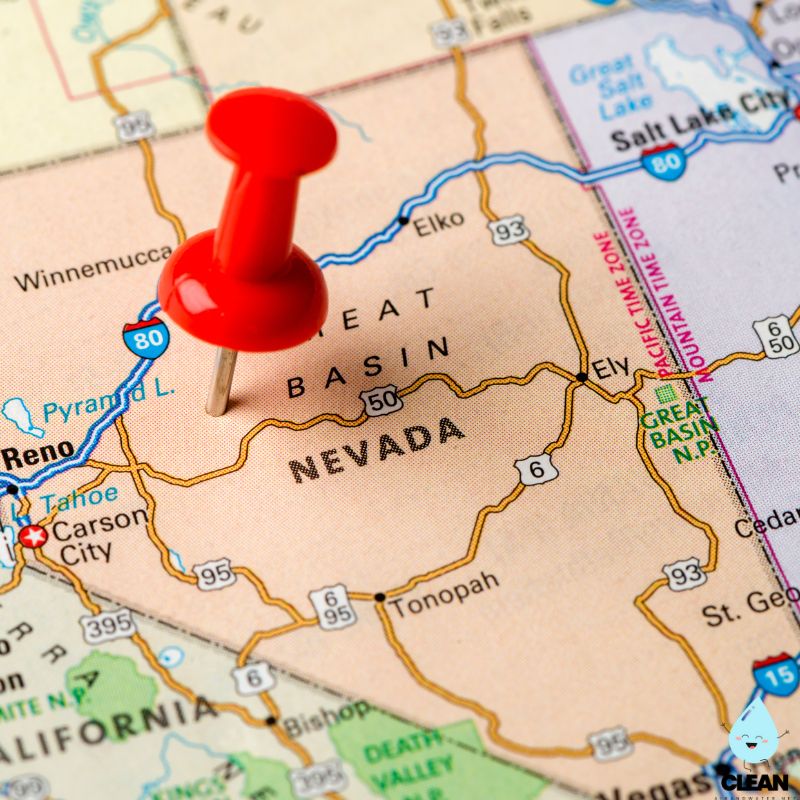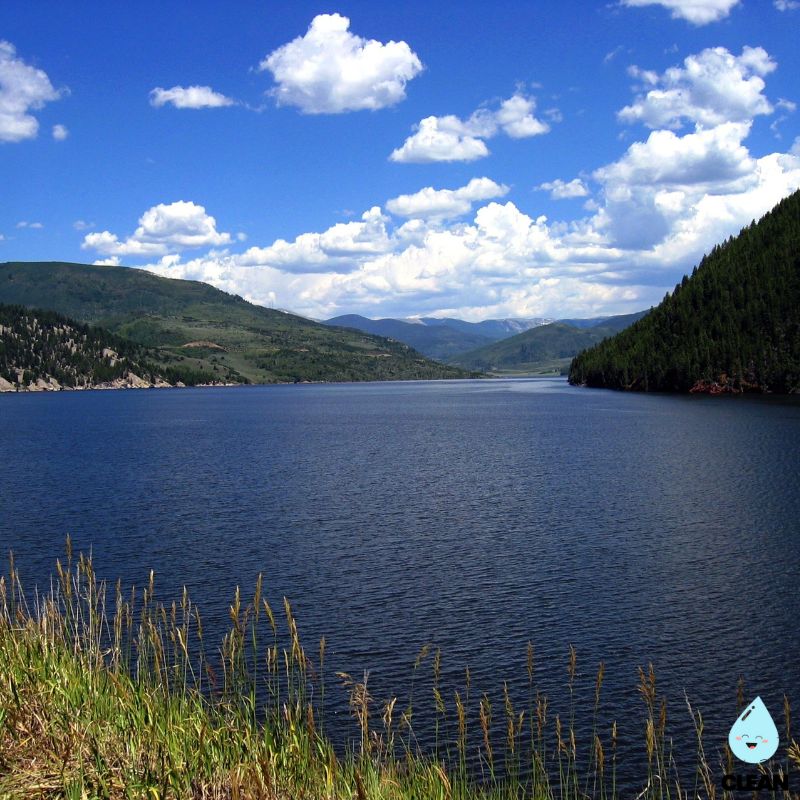Nevada Water Quality at a Glance
regional contamination
Is Nevada Water Safe to Drink?
Generally Safe with Regional Risks – Nevada’s municipal water generally meets federal standards, with Las Vegas showing excellent PFAS testing results. However, significant concerns exist for rural areas where 22% of private wells exceed EPA arsenic limits (some up to 80x higher). Major contaminants include naturally occurring arsenic, uranium, chromium-6, and heavy metals. Northern Nevada faces the highest risk, particularly around Reno, Carson City, and Fallon.
⚠️ Key Concerns for Nevada Residents
- Private Well Contamination: 182,000 people rely on unregulated private wells; 22% exceed arsenic safety limits with some 80x higher than EPA guidelines
- Geographic Hot Spots: Northern Nevada (Reno, Carson City, Fallon) shows highest contamination probability; Carson Desert basin particularly at risk
- Heavy Metal Contamination: Naturally occurring arsenic, uranium, lead, chromium-6, and cadmium found throughout state’s groundwater
- PFAS Monitoring: Two water systems recently flagged for PFAS; statewide testing ongoing through 2027 with federal oversight
Read the full report below for detailed analysis, city-specific data, and actionable recommendations for Nevada residents.
Nevada – The Silver State – Water Quality Report 2025: PFAS Testing, Infrastructure Concerns & Safety across your state
Nevada’s water infrastructure serves approximately 3.2 million residents across a vast desert landscape, from the Colorado River-dependent south to the Truckee River watershed in the north. The state operates through a network of about 600 public water systems, ranging from the Southern Nevada Water Authority serving over 2 million customers in Las Vegas to smaller rural systems providing essential services to remote communities. Nevada’s primary water sources include the Colorado River (Lake Mead), which supplies 90% of Southern Nevada’s water, the Truckee River system serving Reno-Sparks, and numerous groundwater aquifers supporting both urban and agricultural areas across the state.
Despite Nevada’s arid climate and ongoing Colorado River drought challenges, the state maintains generally good water quality standards. According to the Nevada Division of Environmental Protection, approximately 22 systems are currently non-compliant with health-based primary drinking water standards and 12 systems non-compliant with secondary standards out of 600 total systems, representing one of the better compliance rates in the western United States. Nevada has emerged as a leader in PFAS monitoring and water conservation, with comprehensive testing revealing generally lower “forever chemical” concentrations compared to other western states. The state receives federal infrastructure investments to address emerging contaminants and drought resilience, focusing on advanced treatment technologies and sustainable water management. Nevada’s commitment to water quality and conservation is demonstrated through partnerships between the Nevada Division of Environmental Protection, local utilities, and federal agencies working to ensure safe, reliable water access while managing the challenges of the nation’s driest state.

Nevada Water Quality: Current Status (2024-2025)
Statewide Compliance and Testing
- Overall Compliance: Nevada currently has 22 systems non-compliant with health-based primary drinking water standards and 12 systems non-compliant with secondary standards out of approximately 600 public water systems, representing one of the better compliance rates in the western United States.
- PFAS Monitoring: Nevada shows relatively low PFAS contamination compared to other states, with 2023 USGS testing finding no detection of PFAS in three private wells and ten public water system samples, though two water systems were flagged for elevated PFAS in 2025, and comprehensive monitoring continues through 2026.
- Infrastructure Assessment: The EPA estimates Nevada requires $6.4 billion for water system improvements over the next twenty years, with nearly two-thirds needed for distribution and transmission projects serving growing urban areas.
Major Water Sources and Challenges
- Colorado River System: Supplies 90% of Southern Nevada’s water through Lake Mead, currently operating under Tier 1 shortage conditions with a 21,000 acre-feet reduction (7% of Nevada’s allocation) for 2025.
- Truckee River Basin: Primary source for Reno-Sparks region, fed by Lake Tahoe and Sierra Nevada snowpack, with surface water testing showing minimal PFAS contamination compared to national averages.
- Drought and Climate Challenges: Lake Mead has dropped over 150 feet since 2000, requiring unprecedented conservation measures and long-term planning for water security in the nation’s driest state.
Emerging Contaminant Response
- PFAS Regulation Implementation: Nevada is temporarily postponing adoption of federal PFAS rules pending EPA revisions announced in May 2025, with new standards for PFOA and PFOS (4 parts per trillion) taking effect by April 2029 under updated federal guidelines.
- Proactive Monitoring: The state requires comprehensive PFAS testing through UCMR 5 (2023-2026) across all large and medium public water systems, with the 7th set of analytical results representing 66% of expected data released in January 2025.
- Treatment Technology: Water utilities are preparing advanced treatment technologies including activated carbon filtration and reverse osmosis systems for PFAS removal, with research ongoing at Las Vegas Wash and other key watersheds.
Conservation and Sustainability
- Water Conservation Leadership: Southern Nevada has reduced per capita water use by 55% since 2002 despite population growth of 829,000 residents, using the least amount of Colorado River water in 31 years as of 2024.
- Drought Contingency Planning: Nevada contributed 124,000 acre-feet in 2023 under the Lower Basin Drought Contingency Plan, with recovery credits available when Lake Mead levels improve above 1,110 feet.
- Rural System Support: Dedicated funding through federal programs provides grants and technical assistance to smaller systems facing challenges with aging infrastructure and new regulatory requirements, with particular focus on private wells where 22% exceed arsenic limits.
Looking Forward: 2025-2030
Nevada’s water quality and security landscape is defined by successful adaptation to extreme scarcity and emerging challenges. The state’s leadership in water conservation and proactive approach to PFAS monitoring positions Nevada well for meeting new federal regulations by 2029. However, continued success requires ongoing collaboration between federal agencies, state regulators, and water utilities to address Colorado River drought impacts, implement advanced treatment technologies, and ensure equitable access to safe drinking water across urban and rural communities. Special attention is needed for Northern Nevada’s private well users, where 22% of wells exceed EPA arsenic limits. Nevada’s experience managing water scarcity provides valuable lessons for other arid regions facing similar challenges from climate change and growing demands on limited water resources.
Recommendations for Nevada Residents

Know Your Water Source
Contact your water utility to request annual water quality reports and ask about PFAS testing results. Visit NDEP’s website to access your local system’s testing data and understand any contaminants of concern in your area. Private well users should test annually for arsenic and other metals.

Support Water Conservation
Follow mandatory seasonal water restrictions and consider converting non-functional grass to drought-tolerant landscaping. Nevada’s conservation success depends on continued community participation in water-saving initiatives.

Consider PFAS-Certified Filtration
For additional protection, consider NSF-certified activated carbon or reverse osmosis filters specifically tested for PFAS removal. While Nevada shows low contamination levels, these provide extra security as federal standards become more stringent.

Report Water Quality Concerns
Contact your local water utility immediately for taste, odor, or color concerns. Report suspected contamination to NDEP’s Bureau of Safe Drinking Water at (775) 687-9521 for investigation and follow-up.

Monitor Drought Conditions
Stay informed about Lake Mead levels and Colorado River conditions through SNWA and CRC Nevada updates. Understand how drought declarations affect local water availability and conservation requirements.
Nevada Cities We Cover
Las Vegas Water Quality
Comprehensive analysis of Southern Nevada Water Authority systems serving the Las Vegas metropolitan area. Includes information on Colorado River sourcing, treatment processes, conservation programs, and PFAS monitoring in Nevada’s largest city.
North Las Vegas Water Quality
Detailed assessment of North Las Vegas water systems, covering water quality testing, Colorado River dependency, and compliance with emerging contaminant regulations in this rapidly growing community.
Reno Water Quality
Complete evaluation of Truckee Meadows Water Authority serving the Reno-Sparks region. Covers Truckee River sourcing, groundwater systems, water quality monitoring, and infrastructure modernization efforts in Northern Nevada.
Frequently Asked Questions
Is Nevada’s tap water safe to drink?
Nevada’s public water systems generally provide safe drinking water that meets federal standards, with relatively low PFAS contamination compared to other states.
The Nevada Division of Environmental Protection monitors approximately 600 public water systems, with only 22 currently non-compliant with health-based primary drinking water standards. Recent USGS testing found no PFAS detection in most Nevada drinking water samples, though two systems were flagged for elevated levels in 2025. Nevada’s water quality benefits from newer infrastructure compared to many states and proactive monitoring programs. However, private well users face higher risks, with 22% of Northern Nevada wells exceeding EPA arsenic limits. Residents should review their utility’s annual water quality report and stay informed about local conditions.
How does the Colorado River drought affect Nevada’s water?
Nevada faces ongoing water reductions due to historic drought conditions on the Colorado River, which supplies 90% of Southern Nevada’s water.
Lake Mead is currently operating under Tier 1 shortage conditions, reducing Nevada’s allocation by 21,000 acre-feet (7% reduction) for 2025. The reservoir has dropped over 150 feet since 2000 and remains about one-third full. Nevada has responded with unprecedented conservation measures, reducing per capita water use by 55% since 2002 despite adding 829,000 residents. The state also contributed 124,000 acre-feet in 2023 under drought contingency plans. Long-term solutions include continued conservation, diversified water supplies, and regional cooperation among Colorado River Basin states.
How can I find out about my local water quality in Nevada?
Nevada residents can access comprehensive water quality information through several state and local resources:
• Annual Water Quality Reports: Contact your water utility directly for their Consumer Confidence Report, which details all testing results and any violations or concerns
• NDEP Database: Visit the Nevada Division of Environmental Protection’s website to access testing results and compliance information for your local water system
• PFAS Testing Data: NDEP requires comprehensive PFAS testing under UCMR 5 and makes results publicly available on their website
• Drought Information: Check the Colorado River Commission of Nevada and Southern Nevada Water Authority for current drought conditions and conservation requirements
What are Nevada’s main water infrastructure challenges?
Nevada faces unique infrastructure challenges due to extreme aridity and rapid population growth:
Drought Resilience: Managing water security in the nation’s driest state requires extensive conservation programs and drought contingency planning
Growth Management: The EPA estimates Nevada needs $6.4 billion for water system improvements over the next twenty years, with most needed for large systems serving growing urban areas
Source Water Protection: Protecting limited water sources from contamination while meeting increasing demands from tourism and population growth
Rural System Challenges: Smaller systems face higher per-capita costs and limited technical capacity, particularly in remote areas with aging infrastructure and private well contamination
Nevada addresses these challenges through innovative conservation programs, advanced treatment technologies, and coordinated planning between state agencies and water utilities.
Quality News About Your Water
Get the comprehensive water quality news coverage you need with our dedicated US Water News Service. From coast to coast, we deliver in-depth reporting and expert analysis on PFAS contamination, EPA regulatory changes, infrastructure developments, and emerging water safety issues affecting communities nationwide. While mainstream media only covers the biggest stories, we provide the detailed, ongoing coverage that helps you understand the full scope of America’s water challenges. Whether you’re a concerned citizen, water professional, or community leader, our daily updates and analytical insights keep you informed about the issues that matter most to public health and environmental safety.
Contaminants of Concern

PFAS “Forever Chemicals”
Source: Limited industrial manufacturing in Nevada, but potential contamination from firefighting foam use at airports, military bases, and consumer products including non-stick cookware and stain-resistant textiles
Health Effects: Linked to kidney and testicular cancer, liver damage, immune system suppression, high cholesterol, and developmental effects in children
Current Status: Nevada shows relatively low PFAS contamination with no detection in 2023 USGS testing of most public water systems, though two water systems were flagged for elevated PFAS in 2025. Surface water monitoring detected PFAS in Las Vegas Wash and Truckee River areas EPA Limits: 4 ppt for PFOA and PFOS individually, with hazard index for other PFAS compounds taking effect by April 2029

Arsenic and Heavy Metal Contamination
Source: Naturally occurring in Nevada’s volcanic geology and groundwater aquifers, with concentrations varying significantly across the state, particularly in Northern Nevada’s Carson Desert, Carson Valley, and Truckee Meadows
Health Effects: Arsenic linked to bladder, lung, and skin cancers, cardiovascular disease, and developmental harm. Other metals including uranium, lead, and chromium-6 pose additional cancer and organ damage risks
Current Status: 22% of private wells in Northern Nevada exceed EPA arsenic limits (10 µg/L), with some levels 80 times higher than safe limits. 182,000 people rely on private wells statewide. Municipal systems generally meet standards Management Response: Enhanced monitoring, treatment system installations, and public education programs for private well users
Please read – our information
The information presented on cleanairandwater.net is compiled from official water quality reports, trusted news sources, government websites, and public health resources. While we strive for accuracy and thoroughness in our presentations, we are not scientists, engineers, or qualified water quality professionals.
Our mission is to present water quality information in an accessible, real-world format that helps people understand what’s in their water and make informed decisions about their health and safety. We believe that complex environmental information should be available to everyone in a format that’s easy to understand.
We make every effort to ensure our content is current and accurate, but we cannot guarantee that all information is complete or error-free. This website should not replace official communications from your local water utility or health department. We always recommend consulting official sources for the most up-to-date information regarding your specific water system.
Clean Air and Water is not liable for any unintentional errors, omissions, or outdated information. The content on this site is provided for informational purposes only and should not be considered professional advice.


